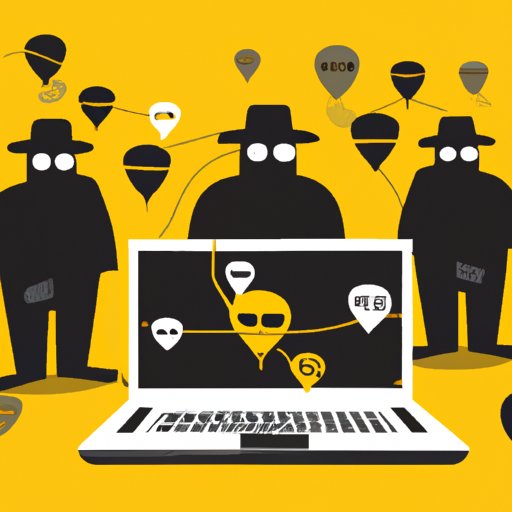Introduction
Cybersecurity is a major concern for individuals, businesses and governments around the world. Bad actors in cybersecurity are those who use digital methods to maliciously exploit weaknesses in computer networks and other systems. Such threats come from a variety of sources and can cause significant damage if left unchecked.
Definition of Bad Actors in Cybersecurity
Bad actors in cybersecurity are individuals or groups that use malicious tactics to gain unauthorized access to computer networks and systems. They may be motivated by financial gain, political agendas, or simply the desire to cause chaos and disruption. Examples of bad actors include hackers, insiders, botnets, and other malicious actors.
Overview of the Problem
The potential damage caused by bad actors in cybersecurity is immense. According to a report from McAfee Labs, the global cost of cybercrime was estimated at $600 billion in 2018. This figure is expected to reach $6 trillion annually by 2021. In addition to financial losses, cyberattacks can also cause serious disruption to services, reputational damage, and even physical harm.
Exploring the Different Types of Bad Actors in Cybersecurity
There are several different types of bad actors in cybersecurity. Each type poses its own unique threat and requires different strategies for prevention and mitigation.
Hackers
Hackers are individuals or groups that attempt to gain unauthorized access to computer networks and systems. They use a variety of techniques, including exploiting software vulnerabilities, social engineering, and phishing attacks. Hackers may be motivated by financial gain, political agendas, or simply the thrill of breaking into secure systems.
Insiders
Insiders are employees or other individuals with legitimate access to an organization’s networks and systems. They may act maliciously, using their access to steal data or disrupt services. Insiders may be motivated by financial gain, revenge, or other personal agendas.
Botnets
Botnets are networks of computers that have been infected with malware and can be used to launch coordinated attacks. Botnets are often used to spread spam, launch distributed denial-of-service (DDoS) attacks, or mine cryptocurrencies. Botnets are difficult to detect and can cause significant damage if left unchecked.

The Impact of Bad Actors on Cybersecurity
Bad actors in cybersecurity can have a devastating impact on organizations. They can damage infrastructure, steal and sell data, and disrupt services. Here are some of the most common effects of bad actors in cybersecurity.
Damaging Infrastructure
Bad actors in cybersecurity can damage infrastructure by exploiting software vulnerabilities, launching DDoS attacks, or infecting computers with malware. Such attacks can lead to data loss, system downtime, and costly repairs. According to a study by Ponemon Institute, the average cost of a data breach is estimated at $3.86 million.
Stealing and Selling Data
Bad actors in cybersecurity can also steal confidential data and sell it on the black market. Data theft can lead to financial losses, reputational damage, and legal action. In 2017, Equifax reported a data breach that exposed the personal information of over 143 million people.
Disrupting Services
Bad actors in cybersecurity can also disrupt services by taking down websites or disrupting communication networks. Such disruptions can lead to lost productivity and revenue. In 2016, a distributed denial-of-service attack caused outages across the United States and Europe, affecting millions of users.

How to Identify and Prevent Bad Actors in Cybersecurity
Organizations need to take proactive steps to identify and prevent bad actors in cybersecurity. Here are some of the most effective methods for doing so.
Implementing Security Protocols
Organizations should implement comprehensive security protocols, such as firewalls, anti-malware software, and encryption. Such measures can help to detect and block malicious activity. Organizations should also regularly update their security protocols to ensure that they remain effective against new threats.
Training Employees and Educating Users
Organizations should provide employees with adequate training on cybersecurity and educate users on how to identify and avoid malicious activity. Employees and users should be made aware of the potential risks posed by bad actors and be taught how to recognize suspicious behavior.
Using Intrusion Detection Systems
Organizations should also consider using intrusion detection systems (IDS) to monitor network traffic for signs of malicious activity. IDS can detect intrusions in real time and alert administrators to potential threats. Organizations should also regularly review their IDS logs to ensure that they are up to date.
The Role of Governments in Combating Bad Actors in Cybersecurity
Governments have an important role to play in combating bad actors in cybersecurity. Governments should establish laws and regulations to protect citizens and organizations from malicious activity. They should also provide resources for cybersecurity research and development, and work with international partners to share best practices and coordinate response efforts.
Establishing Laws and Regulations
Governments should establish laws and regulations to protect citizens and organizations from cyberattacks. For example, the European Union has implemented the General Data Protection Regulation (GDPR) to protect the personal data of EU citizens. Such laws and regulations can help to deter bad actors and hold organizations accountable for any breaches.
Providing Resources for Cybersecurity
Governments should also provide resources for cybersecurity research and development. This can include funding for research projects, grants for startups, and incentives for companies to invest in cybersecurity. Such investments can help to strengthen the cyber defenses of organizations and reduce the risk of attacks.
Working with International Partners
Finally, governments should work with international partners to share best practices and coordinate response efforts. For example, the United Nations has established the Global Forum on Cyber Expertise to foster collaboration between countries and promote the sharing of expertise and resources. Such collaborations can help to improve global cybersecurity.

Investigating the Costs of Bad Actors in Cybersecurity
Bad actors in cybersecurity can cause significant financial losses. Here are some of the most common costs associated with cybercrime.
Direct Financial Losses
Organizations can suffer direct financial losses due to cyberattacks. These losses can include stolen funds, lost revenue, and increased expenses for repairs and restoration. According to a survey by Kaspersky Lab, the average cost of a data breach for large organizations is estimated at $1.25 million.
Indirect Costs of Reputation Damage
Organizations can also suffer indirect costs due to reputational damage caused by a cyberattack. Customers may lose trust in an organization, leading to decreased sales and lower stock prices. According to a report by IBM Security, the average cost of reputation damage due to a data breach is estimated at $3.92 million.
Cost of Regulatory Compliance
Organizations can also face additional costs due to regulatory compliance. Governments may impose fines or require organizations to implement additional security measures. According to a study by the Ponemon Institute, the average cost of regulatory compliance is estimated at $1.24 million.
Conclusion
Bad actors in cybersecurity pose a major threat to organizations. They can damage infrastructure, steal and sell data, and disrupt services. Organizations need to take proactive steps to identify and prevent such threats, such as implementing security protocols, training employees, and using intrusion detection systems. Governments also have an important role to play in combating bad actors, by establishing laws and regulations, providing resources for cybersecurity, and working with international partners. Finally, organizations need to be aware of the potential costs of cybercrime, including direct financial losses, reputational damage, and regulatory compliance.
By understanding the different types of bad actors in cybersecurity, the impact they can have, and the steps that can be taken to mitigate them, organizations can better protect themselves and their customers from malicious activity.
(Note: Is this article not meeting your expectations? Do you have knowledge or insights to share? Unlock new opportunities and expand your reach by joining our authors team. Click Registration to join us and share your expertise with our readers.)
